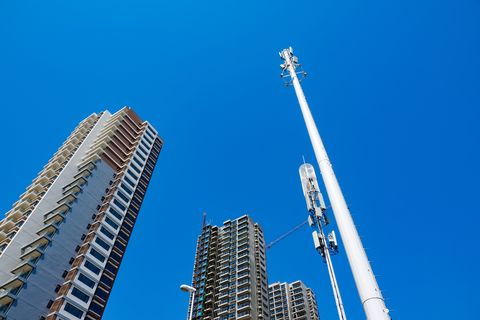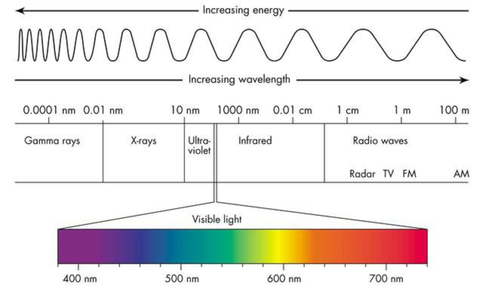I’ve shown before that the 5G – Covid – vaccines connection is actually DATA.
Now we learn it’s energy too.
Of course this is not a novel idea, but the announcement made by Georgia tech and more counts as an official confirmation that they pursue this concept
To get the effect above you also need this:
No more device batteries? Researchers at Georgia Institute of Technology’s ATHENA lab discuss an innovative way to tap into the over-capacity of 5G networks, turning them into “a wireless power grid” for powering Internet of Things (IoT) devices. The breakthrough leverages a Rotman lens-based rectifying antenna capable of millimeter-wave harvesting at 28 GHz. The innovation could help eliminate the world’s reliance on batteries for charging devices by providing an alternative using excess 5G capacity. – Georgia Tech, March 2021
We Could Really Have a Wireless Power Grid That Runs on 5G
This tech might make us say goodbye to batteries for good.
POPULAR MECHANICS APR 30, 2021 COURTESY OF CHRISTOPHER MOORE / GEORGIA TECH
COURTESY OF CHRISTOPHER MOORE / GEORGIA TECH
- Researchers at Georgia Tech have come up with a concept for a wireless power grid that runs on 5G’s mm-wave frequencies.
- Because 5G base stations beam data through densely packed electromagnetic waves, the scientists have designed a device to capture that energy.
- The star of the show is a specialized Rotman lens that can collect 5G’s electromagnetic energy from all directions.
If you’ve ever owned a Tile tracker—a square, white Bluetooth beacon that connects to your phone to help keep tabs on your wallet, keys, or whatever else you’re prone to losing—you’re familiar with low-power Internet-of-Things (IoT) devices.
Just like other small IoT devices, from voice assistants to tiny chemical sensors that can detect gas leaks, Tile trackers require a power source. It’s not realistic to hook these gadgets up to a wall outlet, and having to constantly change batteries is a waste of time that’s ultimately bad for the environment.
But what if you could wirelessly charge those devices with a power source that’s already all around you? Researchers at Georgia Tech have dreamed up this kind of “wireless power grid” with a small device that harvests the electromagnetic energy that 5G base stations routinely emit.
Just like the 3G and 4G cell phone towers that came before, 5G base stations radiate electromagnetic energy. At the moment, we’re only harnessing these precious bands of energy to transfer data (which helps you download your favorite Netflix series at lightning speeds).This content is imported from YouTube. You may be able to find the same content in another format, or you may be able to find more information, at their web site.
With some crafty engineering, it’s possible to use 5G’s waves of energy as a form of wireless power, says Manos Tentzeris, Ph.D., a professor of flexible electronics at Georgia Tech. He leads the university’s ATHENA research group, where his team has fabricated a specialized Rotman lens “rectenna” that makes this energy collection possible.
If the idea takes off, this tiny device—which is really a small, high-tech sticker—can use the wireless power grid to charge up far more devices than just your Tile tracker. Your cell phone providers could start beaming out electricity to power all kinds of small electronics, from delivery drones to tracking tags for pallets in a “smart warehouse.” The possibilities are truly endless.
“If you’re talking about real-world implementation of all of these ambitious projects, such as IoT, smart cities, or digital twins … you need to have wireless sensors everywhere,” Tentzeris tells Pop Mech. “But currently, all of them need to have batteries.”
But Wait, How Does 5G Create Power?

Let’s start out with the basics: 5G technically is energy.
5G can seem like a black box to those of us who aren’t electrical engineers, but the premise hinges on something we can all understand: electromagnetic energy. Consider the visible spectrum, or all of the light you can see. It exists along the larger electromagnetic spectrum, but it’s really just a blip.
In the graphic below, you can see the visible spectrum is just between ultraviolet and infrared light, or between 400 and 700 nanometers. As energy increases along the electromagnetic spectrum, the waves become shorter and shorter—notice gamma rays are far more powerful, and have more densely packed waves than FM radio, for example. Human eyes can’t detect these waves of energy.

PRINCIPLES OF STRUCTURAL CHEMISTRY
5G is also invisible and operates at a higher frequency than other communication standards we’re used to, like 3G or 4G. Those networks work at frequencies between about 1 to 6 gigahertz, while experts say 5G sits closer to the band between 24 and 90 gigahertz.
Because 5G waves function at a higher frequency, they’re more powerful, but also shorter in length. This is the primary reason why new infrastructure (like small 5G cells installed on utility poles) is required for 5G deployment: the waves have different characteristics. Shorter waves, for example, will see more interference from objects like trees and skyscrapers, and even droplets of rain or flakes of snow.
But don’t think of a city’s constellation of 5G base stations as wasteful. Old standards, like 3G and 4G, are known for indiscriminately emitting power from massive service towers in all directions, beaming significant amounts of untapped energy. 5G base stations are much more efficient, says Jimmy Hester, Ph.D., a Georgia Tech alum who serves as senior lab advisor to the ATHENA group.
“Because they operate at high frequencies, [5G base stations] are much better able to focalize [power]. So there’s less waste in a sense,” Hester tells Pop Mech. “What we’re talking about is more of an intentional energization of the devices, themselves, by focalizing the beam towards the device in order to turn it on and power it.”
A ‘Tarantula’ Lens Takes Shape

There’s a drawback to this efficient focalization: 5G base stations transmit energy in a limited field of view. Think of it like a beam of energy moving in one direction, rather than a circle of energy emanating from a tower. The researchers call it a “pencil beam.” How could a small device precisely snatch up energy from all of these scattered base stations, especially when you can’t see the direction in which the waves are traveling?
Enter the Rotman lens, the key technology behind the team’s breakthrough energy-harvesting device. You can see Rotman lenses at work in military applications, like radar surveillance systems meant to identify targets in all directions without having to actually move the antenna. This isn’t the prototypical lens you’re used to seeing in a pair of glasses or in a microscope. It’s a flexible lens with metal backing, the team explains in a new research paper published in Scientific Reports.
“THE LENS IS LIKE A TARANTULA…[IT] CAN LOOK IN SIX DIFFERENT DIRECTIONS.”
“The same way the lens in your camera collects all of the [light] waves from any direction, and combines it to one point…to create an image, that’s exactly how [this] lens works,” Aline Eid, a Ph.D. student and senior researcher at the ATHENA lab, tells Pop Mech. “The lens is like a tarantula … because a tarantula has six eyes, and our system can also look in six different directions.”
The Rotman lens increases the energy collecting device’s field of view from the “pencil beam” of about 20 degrees to more than 120 degrees, Eid says, making it easier to collect millimeter-wave energy in the 28-gigahertz band. So even if you slapped the sticker onto a moving drone, you could still reliably collect energy from 5G base stations all over a city.
“If you stick these devices on a window, or if you stick these devices on a light pole, or in the middle of an orchard, you’re not going to know the map of the strongest-power base stations,” Tentzeris explains. “We had to make our harvesting devices direction agnostic.”
Your Cell Phone Plan, Reimagined

COURTESY OF CHRISTOPHER MOORE / GEORGIA TECH
Tentzeris says he and his colleagues are looking for funding and eager to work with telecom companies. It makes sense: these companies could integrate the rectenna stickers around cities to augment the 5G networks they’re already building out. The end result could be a sort of new-age cell phone plan.
“In the beginning of the 2000s, companies moved from voice to data. Now, using this technology, they can add power to data/communication as well,” Tentzeris says.
Right now, the rectenna stickers can’t collect a huge amount of power—just about 6 microwatts of electricity, or enough to power some small IoT devices, from 180 meters away. But in lab tests, the device is still able to gather about 21 times more energy than similar devices in development.This content is imported from {embed-name}. You may be able to find the same content in another format, or you may be able to find more information, at their web site.
Plus, accessibility is on the team’s side, since the system is fully printable. Tentzeris says it only costs a few cents to produce one unit through additive manufacturing. With that in mind, he says it’s possible to embed the rectenna sticker into a wearable or even stitch it into clothing.
“Scalability was very important, you’re talking about billions of devices,” Tentzeris says. “You could have a great prototype working in the lab, but when somebody asks, ‘Can everybody use it?’ you need to be able to say yes.” – POPULAR MECHANICS 2021
ATHENA (Agile Technologies for High-performance Electromagnetic Novel Applications)
The ATHENA (Agile Technologies for High-performance Electromagnetic Novel Applications) group at Georgia Tech, led by Dr. Manos Tentzeris, explores advances and development of novel technologies for electromagnetic, wireless, RF and mm-wave applications in the telecom, defense, space, automotive and sensing areas.

In detail, the research activities of the 15-member group include Highly Integrated 3D RF Front-Ends for Convergent (Telecommunication,Computing and Entertainment) Applications, 3D Multilayer Packaging for RF and Wireless modules, Microwave MEM’s, SOP-integrated antennas (ultrawideband, multiband, ultracompact) and antenna arrays using ceramic and conformal organic materials and Adaptive Numerical Electromagnetics (FDTD, MultiResolution Algorithms).
The group includes the RFID/Sensors subgroup which focuses on the development of paper-based RFID’s and RFID-enabled “rugged” sensors with printed batteries and power-scavenging devices operating in a variety of frequency bands [13.56 MHz-60 GHz]. In addition, members of the group deal with Bio/RF applications (e.g. breast tumor detection), micromachining (e.g elevated patch antennas) and the development of novel electromagnetic simulator technologies and its applications to the design and optimization of modern RF/Microwave systems.
The numerical activity of the group primarily includes the finite-difference time-domain (FDTD) and multiresolution time-domain (MRTD) simulation techniques. It also covers hybrid numerical simulators capable of modeling multiple physical effects, such as electromagnetics and mechanical motion in MEMS devices and the combined effect of thermal, semiconductor electron transport, and electromagnetics for RF modules containing solid state devices.
The group maintains a 32 processor Linux Beowulf cluster to run its optimized parallel electromagnetic codes. In addition, the group uses these codes to develop novel microwave devices and ultracompact multiband antennas in a number of substrates and utilizes multilayer technology to miniaturize the size and maximize performance. Examples of target applications include cellular telephony (3G/4G), WiFi, WiMAX, Zigbee and Bluetooth, RFID ISO/EPC_Gen2, LMDS, radar, space applications, millimeter-wave sensors and surveillance devices and emerging standards for frequencies from 800MHz to 100GHz.
The activities are sponsored by NSF, NASA, DARPA and a variety of US and international corporations. – ATHENA

MIT can charge implants with external wireless power from 125 feet away
By Digital Trends — Posted on June 6, 2018

Smart implants designed for monitoring conditions inside the body, delivering drug doses, or otherwise treating diseases are clearly the future of medicine. But, just like a satellite is a useless hunk of metal in space without the right communication channels, it’s important that we can talk to these implants. Such communication is essential, regardless of whether we want to relay information and power to these devices or receive data in return.
Fortunately, researchers from Massachusetts Institute of Technology (MIT) and Brigham and Women’s Hospital may have found a way to help. Scientists at these institutes have developed a new method to power and communicate with implants deep inside the human body.
“IVN (in-vivo networking) is a new system that can wirelessly power up and communicate with tiny devices implanted or injected in deep tissues,” Fadel Adib, an assistant professor in MIT’s Media Lab, told Digital Trends. “The implants are powered by radio frequency waves, which are safe for humans. In tests in animals, we showed that the waves can power devices located 10 centimeters deep in tissue, from a distance of one meter.”
These same demonstration using pigs showed that it is possible to extend this one-meter range up to 38 meters (125 feet), provided that the sensors are located very close to the skin’s surface. These sensors can be extremely small, due to their lack of an onboard battery. This is different from current implants, such as pacemakers, which have to power themselves since external power sources are not yet available. For their demo, the scientists used a prototype sensor approximately the size of a single grain of rice. This could be further shrunk down in the future, they said.
“The incorporation of [this] system in ingestible or implantable device could facilitate the delivery of drugs in different areas of the gastrointestinal tracts,” Giovanni Traverso, an assistant professor at Brigham and Women’s Hospital and Harvard Medical School, told us. “Moreover, it could aid in sensing of a range of signals for diagnosis, and communicating those externally to facilitate the clinical management of chronic diseases.”
The IVN system is due to be shown off at the Association for Computing Machinery Special Interest Group on Data Communication (SIGCOMM) conference in August.
More info : https://www.media.mit.edu/projects/ivn-in-vivo-networking/overview/
Buh-bye, Human race, you’ve just been assimilated by the Borg!
To be continued?
Our work and existence, as media and people, is funded solely by our most generous supporters. But we’re not really covering our costs so far, and we’re in dire needs to upgrade our equipment, especially for video production.
Help SILVIEW.media survive and grow, please donate here, anything helps. Thank you!
! Articles can always be subject of later editing as a way of perfecting them

